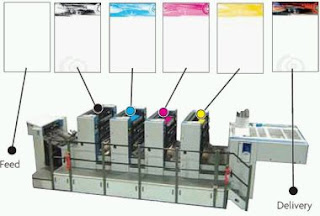Commercial print processes
'Printing is process that applies ink or varnish from a printing plate to a substrate through the application of pressure' The production Manual p152
Commercial printing is practical, technical and economical (or should be!)
Rotary printing
Offset Lithography (Litho)
Planographic
The inked image is transferred or offset from a etched aluminium printing plate onto a rubber blanket roller which is then pressed against the paper or other substrate. Th principle behind Litho relies on the fact that oil and water repel each other. As the plate passes under the ink roller the non-image area of the plate have a water film that repels the oily inks on the image areas.
Lithography is generally 4 colour printing CMYK with from 2 up to six spot colours. Spellman Walker had just purchased a ten colour machine. It can produce a good photographic reproduction and fine linework on a variety of stocks. The printing plates are easy to prepare, even more so with new technology. The high level of machine preparation and also high speeds means this is more suitable for high volume runs.
Sheet fed printing presses are used for lower production runs such as brochures and magazines whilst a continuous web press is used for higher volumes such as newspapers and magazines.Sheet fed printing presses are typically fed with a 'ream' of paper at a time. A ream is a block of 500 sheets. Massive rolls of stock are used on web printing stocks rather than sheets. This means lower production costs can be achieved. Webs are more commonly used with Rotogravure and flexography. An advantage of roll fed printing is lighter paper stocks can be used than with sheet fed. This reduces bulk and weight say in book production which can then mean distribution and packaging costs are cheaper.
Problems
Very high print runs image quality can suffer due to wear on the plate.
Ink and water balance on the plate can cause problems with colour control and cause colour variation.
Water can cause absorbent substrates to distort.
Mis-registration caused by mis-aligned printing plates
Examples
Rotogravure (Gravure)
Intaglio etching. Copper plates(with mirror image) transfer ink directly, not offset, to a print surface, usually on rolls. Advantage , plates are more durable and so are good for long print runs. High volume and good quality so more expensive than litho.
Typical Rotogravure applications
Flexography(Flexo)
"relief'
Commonly used for packaging for food and sweets with high volume but lower quality printing. A positive mirror image on a rubber polymer plate with typically 2mm relief transfers sticky ink direct to the surface. usually roll fed.
Examples
'When you purchase plastic roll banners, you also purchase the plates required for printing them. These plates are a pivotal part of the printing process. They are the vehicle through which ink is transferred onto the plastic. Since we print with this flexo technology, every color you use in your design requires its own plate.
Here’s the great news about your plates: once you purchase plates for a design, you’ll never have to purchase them again! This is the truly wonderful thing about plastic roll banners and flexo-printing: your plates can be used and re-used as many times as you want! What’s more is that we will store your plates for free for as long as you would like. NorthCoast Banners is here to serve our clients. We have not forgotten that the customer comes first.
Flexo Print Quality
Originally, flexo printing was very low quality. In the last few decades great advances have been made, including improvements to the plate material and the method of plate creation - usually photographic exposure followed by chemical etch, though also by direct laser engraving. Laser-etched anilox rolls also play a part in the improvement of print quality.
Full color picture printing now occurs, and some of the finer presses available today in combination with a skilled operator allow quality that rivals the lithographic process.
Flexo has an advantage over lithography in that it can use a wider range of inks and is good at printing on a variety of different materials. Flexo inks, unlike those used in lithography generally have low viscosity. This enables faster drying and as a result, faster production, which means low cost.
Our printing presses average speeds of 450 linear feet per minute.'
Read more: http://www.northcoastbanners.com/flexographic-printing-plastic-roll-banners-bags#ixzz1arm5KRxD
Read more: http://blog.northcoastbanners.com/page/2/#ixzz1arlrLnhk
The reproduction of images by translating the digital code directly from a computer to the sheet without intermediate physical process. No mechanical process, typically short runs or specials of less than 500 copies on a variety of stocks including paper and metal.
Screen Printing
A printmaking technique that uses a woven mesh to support an ink blocking stencil. Can be manual and mechanical. Used for CD printing. Also rotary screen printing for bottles and tubes.
Pad printing
2D image on a 3D object
Examples
Linen tester used to scrutinise print quality as they magnify
























Hi there I am so thrilled I found your website, I really found you by mistake, while I was browsing on Yahoo for something else.
ReplyDeleteCommercial Screen Printing Machine